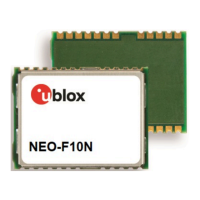NEO-F10N-Integration manual
The NEO-F10N RF front-end is designed for highest immunity against RF interference and is
suitable for designs with a cellular transmitter. The integrated RF circuit includes an L1, L5 dual-
band diplexer SAW filter followed by a low-noise amplifier (LNA) and a second SAW filter stage at
both GNSS bands. There is also an LTE B13 notch filter in front of the LNA at L1 band. The dual-
band SAW–LNA–SAW circuit with built-in LTE Band 13 suppression efficiently rejects out-of-band
blocking signals and amplifies the GNSS signal enhancing the sensitivity of the receiver. The RF
input is matched to 50 Ω and includes a built-in DC block.
Refer to the Block diagram for an overview of the RF front-end.
4.2.1 Internal LNA modes
In addition to the L1 and L5 band LNAs integrated in the RF front-end circuit in NEO-F10N, there
are internal LNAs in the u-blox F10 receiver.
The internal L1 and L5 band LNAs in the receiver have three operating modes: normal gain, low gain,
and bypass mode.
• By default, the internal L1 and L5 band LNAs are configured for the normal-gain mode for
optimized sensitivity. For designs with external gain above 25 dB, the low-gain or bypass mode
must be used to maintain the dynamic range.
• The low-gain mode can be used up to 35 dB total external gain. There are also minor
improvements in immunity and power consumption in the low-gain mode.
• The bypass mode can be used up to 45 dB external gain. There are further improvements in
immunity and power consumption in the bypass mode.
The internal LNA mode can be configured at run time in the RAM, BBR and flash layers using the
configuration item CFG-HW-RF_LNA_MODE and applying a reset. Once in production, the flash layer
can be configured to automatically apply the configuration at every startup. For more information,
refer to Internal LNA mode configuration .
For information on RF parameters, refer to the NEO-F10N data sheet [1] .
4.2.2 Out-of-band blocking immunity
Out-of-band RF interference may degrade the quality and availability of the navigation solution.
Out-of-band immunity limit describes the maximum power allowed at the receiver RF input with no
degradation in performance. Minor violation of the immunity limit may reduce C/N0 of the received
signals but does not necessarily affect the overall receiver performance. However, a significant
violation may reduce receiver sensitivity or cause a complete loss of signal reception. The severity of
the interference depends on the repetition rate, frequency, signal level, modulation, and bandwidth
of the signal.
A typical out-of-band immunity limit at the NEO-F10N RF input for the normal gain (default) mode
is +13 dBm at 400–1070 MHz, 1280–1460 MHz, and 1710–3300 MHz. The immunity decreases
closer to the GNSS in-band. The limit is defined at room temperature using a test signal with 64QAM
modulation and 10 MHz bandwidth similar to an LTE signal.
If the out-of-band immunity limit is exceeded, it is recommended to verify that the receiver
performance is not affected or is at an acceptable level in the presence of interference.
4.2.3 Out-of-band interference
RF interference is typically first coupled into the antenna and subsequently conducted into the
receiver input. Typical out-of-band interference sources include transmitting antennas of other
UBXDOC-963802114-12193 - R02
4 Hardware integration Page 22 of 42
C1-Public

